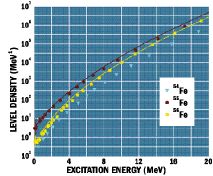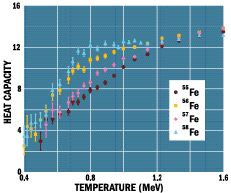

 Skip to navigation
Skip to navigation
Site Primary Navigation:
- About SDSC
- Services
- Support
- Research & Development
- Education & Training
- News & Events
Search The Site:

| FUNDAMENTAL PHYSICS | Contents | Next
|
|
Nuclear Structure and the First Steps Toward Supernovas |
|
| FEATURED Yoram Alhassid, Yale University |
|
|
THE SHELL GAMEA MONTE CARLO METHODNUCLEAR PROPERTIES AND SUPERNOVAS |
|
|
|
 |
 |
Figure 2. Calculated heat capacity versus temperature for iron isotopesYoram Alhassid's simulations demonstrate the enhanced heat capacity for even-mass iron isotopes Fe56 and Fe58 due to pairing. |
Figure 1. Level densities of iron isotopes versus excitation energyA staggered effect in the level densities between odd and even mass is nicely reproduced by the microscopic calculations by Yoram Alhassid. The symbols are the Monte Carlo calculations, and the solid lines are experimental results. (There are no experimental results for Fe54.) |
|
|
|
THE SHELL GAMEOver the years, various models for the structure of the nucleus have been suggested to explain the observed properties of nuclei. In the collective model, the nucleons all move together like a droplet of liquid. For certain properties, such as vibration, rotation, and fission of the nuclear droplet, experiments support this model. In the non-interacting shell model, each nucleon moves independently but feels some average force due to all the other nucleons. Each nucleon has an energy level, and levels with similar energies are bunched together into shells. Other experimental observations, such as the "magic numbers" corresponding to completely filled shells, have supported this model. Alhassid's computations support a third, more realistic model, called the interacting shell model. In this model, the nucleons are arranged in shells as in the non-interacting shell model, but residual forces between the nucleons in the outer (valence) shells are taken into account and have important effects on the structure of the nucleus. The interacting shell model--when it can be solved--provides a much more accurate description of various measured nuclear properties than the first two models. Computationally, however, the interacting shell model presents a major challenge. For light nuclei, in which the valence shells are small or contain only a few protons and neutrons, the model can be solved directly by standard computational methods. On the other hand, for medium- and heavy-mass nuclei--and nuclei of this size are important in astrophysical applications--the direct computations become intractable on even the most powerful computers. "The problem is that the interactions among nucleons lead to very complex states that contain contributions from all possible arrangements of the nucleons in the valence shells," Alhassid said. The number of possible arrangements grows exponentially with the number of nucleons. "If you have only a few nucleons in the valence shell, or if the nucleons do not interact with each other, it's relatively easy. But once you have interactions or larger numbers of nucleons, it becomes very difficult to solve the problem exactly, and many nuclear properties are sensitive to correlations among the nucleons and require an exact solution." The level density is one such property. The level density is the number of possible excited states, or the number of ways nucleons can be arranged, for a given energy range, usually measured in millions of electron volts (MeV). At higher energies, nucleons have more ways to be arranged in the shells and hence many more excited states. Knowing the level density is important for understanding the rate of nuclear reactions. For example, the probability of a reaction known as neutron capture--adding a neutron to a nucleus--is proportional to the nucleus's level density. Neutron capture reactions are critical in the synthesis of elements heavier than iron. |
Top | Contents | Next
REFERENCES Alhassid, Y. 1999. Monte Carlo methods for the nuclear shell model: Recent applications. in Highlights of Modern Nuclear Structure: Proceedings of the 6th International Spring Seminar on Nuclear Physics, ed. A. Covello, 209–212. Singapore: World Scientific. Alhassid, Y., S. Liu, and H. Nakada. 1999. Particle-number reprojection in the shell model Monte Carlo method: Application to nuclear level densities, Physical Review Letters 83: 4265. |
A MONTE CARLO METHODTo study the properties of heavy nuclei, Alhassid and colleagues at Caltech are using a Monte Carlo technique that allows the calculation of nuclear properties in the complete shell model space while avoiding the intractability of the direct methods. In general, Monte Carlo methods use statistical random sampling over a range of possibilities to achieve an approximate solution. In the Monte Carlo approach to the shell model, larger nuclei can be studied by replacing the complicated problem of interacting nucleons with many simple problems of non-interacting nucleons. "The price you pay, however, is having to solve the non-interacting shell problem many times," Alhassid said. "We have to do three or four thousand samples for a single nucleus at a given temperature. The time for each sample depends on the size of the nucleus. And normally we must repeat the calculation for many temperatures." These computations provide information on several nuclear properties, not just level density. Before the method could be applied to perform realistic calculations, Alhassid and collaborators had to overcome a major obstacle known as the Monte Carlo "sign" problem. The sign of the contribution from different samples fluctuates between positive and negative, and the calculated property is the result of a delicate cancellation that cannot be reproduced with a finite number of samples. The sign problem appears in all realistic interactions in the nuclear shell model and becomes more acute at lower temperatures. Alhassid's solution estimates a physically meaningful value by mathematically defining interactions without a sign problem and extrapolating the correct interaction. For certain nuclear properties, equivalent interactions, free of the sign problem, can be substituted directly. With the Monte Carlo method, an integration over many variables is performed by sampling non-interacting problems according to their relative weight. Each sample takes one to two minutes on NPACI's 144-processor IBM SP at SDSC, so a single nucleus in the iron region at a single temperature requires approximately 5,000 minutes. At higher temperatures a run takes less time. In about 1,500 node hours, Alhassid's group can study one nucleus. For typical runs, they use 32 processors. For a larger number of processors, the efficiency decreases somewhat since the first part of the program, called thermalization, incurs an overhead that increases with the number of nodes. |
Top | Contents | Next |
NUCLEAR PROPERTIES AND SUPERNOVASThe formation of elements lighter than iron inside massive stars is the result of fusion reactions, but heavier elements are formed via a complex network of reactions known as r and s processes. These processes determine the abundance of heavy elements through a competition between neutron-capture and beta-decay reactions. The rates of these reactions depend on nuclear structure properties, but many of the nuclei involved in these processes are unstable and their properties are poorly understood. It is therefore important to be able to calculate their properties microscopically. The Monte Carlo approach to the shell model enables such calculations. "We were able to explain things that people had been unable to explain before," Alhassid said. "For example, we were able to calculate the level density from first principles. It had been understood before but only on an empirical level." Neutron-capture reactions in the r and s processes are directly affected by the nuclear level density. Calculations of level densities by Alhassid's group agree well with the experimental data when available, with no adjustable parameters in the calculations (Figure 1). Another important nuclear phenomenon is pairing. Under the influence of a short-range attractive force, nucleons prefer to form pairs. (A similar pairing among electrons in metals leads to superconductivity.) Pairing is stronger in nuclei when the numbers of both protons and neutrons are even since all nucleons can be paired together. Pairing affects other nuclear properties including level densities. Without pairing, for example, the level density of the heavier Fe56 (even number of neutrons) would be larger than that of Fe55 (odd number of neutrons). With pairing, however, the situation is reversed, as in Figure 1. Nucleon pairs can break up at higher temperatures. Energy is required to break the pairs, which leads to a peak in the heat capacity in a macroscopic system. However, it was not clear whether such a peak also exists in the microscopic nuclear system. Alhassid and graduate student Shichang Liu calculated the heat capacity of iron isotopes (Figure 2) and found a shallow peak that is more pronounced for isotopes with an even number of neutrons (Fe56 and Fe58) than for isotopes with an odd number of neutrons (Fe55 and Fe57). Another success of the Monte Carlo method was the calculation of electron capture rates, a process in which a nucleus captures an electron and changes a proton into a neutron. In stars, electron capture by iron-region nuclei reduces the electron pressure and contributes to pre-supernova collapse. A wealth of experimental data on unstable nuclei is expected in the near future from new radioactive beam facilities. The understanding of their structure is important in various astrophysical applications and in tests of fundamental symmetries. The Monte Carlo approach is a promising method for learning about the structure of these nuclei. "Using parallel architectures, we are planning to address a variety of interesting problems in nuclear physics and astrophysics that could not be solved previously," Alhassid said. "And many of the techniques we develop should also be useful in other areas of physics that require a solution to the interacting many-body problem." --DH * |
Top | Contents | Next |